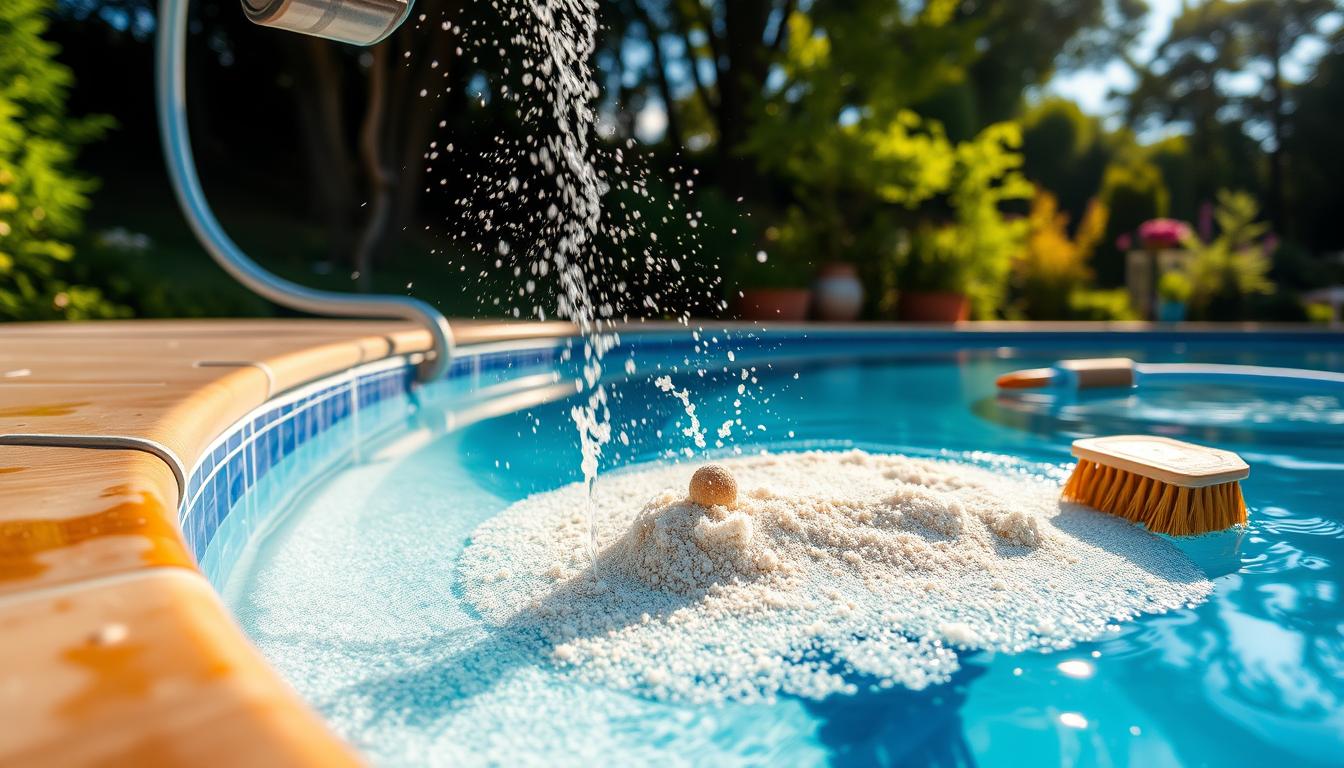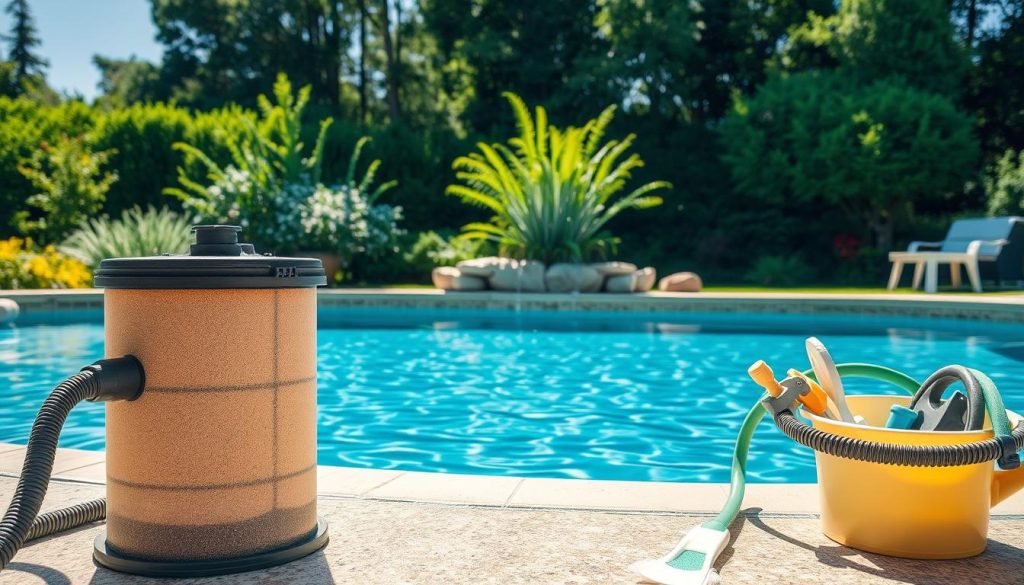
Imagine a perfect summer day ruined by a cloudy pool. High filter pressure signals it’s time for maintenance. Don’t fret! Cleaning your pool sand filter is a breeze with these simple steps.
Regular pool filter maintenance keeps swimming pools clean and healthy. Sand filters are popular for their durability and ease of use. They catch tiny particles, ensuring crystal-clear water.
Over time, sand filters can get clogged with debris. This reduces efficiency and affects water circulation. Filter backwashing helps restore performance and extends the filter’s life.
Following some pool service tips and cleaning guidelines will keep your sand filter in top shape. This ensures a sparkling clean pool throughout the season.
Understanding Your Pool Sand Filter
Pool owners need to know how their filtration systems work. This knowledge ensures top performance and clear water. Let’s explore pool filter types and why regular maintenance matters.
Types of Pool Filters
There are three main types of pool filters. These include cartridge filters, sand filters, and diatomaceous earth (DE) filters. Each type has its own features and advantages.
| Filter Type | Characteristics |
|---|---|
| Cartridge Filters |
|
| Sand Filters |
|
| DE Filters |
|
Importance of Regular Filter Maintenance
Cleaning pool components, especially the filter, is crucial. It keeps the swimming environment healthy and inviting. Signs it’s time to clean include:
- Rise in the pressure gauge reading
- Reduced water flow
- Cloudy water
- Algae growth
Cleaning frequency depends on pool use and environment. A good rule is to clean or backwash monthly. Sand filters need backwashing every few weeks.
Cartridge filters should be cleaned when pressure increases 8-10 psi above normal. Clean filters maintain balanced water chemistry and prevent algae growth. They also ensure safe, enjoyable water for swimmers.
Neglecting filter maintenance can lead to costly repairs. It may also increase energy use. Regular cleaning and media replacement extend the filtration system’s life. This ensures a sparkling clean pool all season.
Steps to Clean Your Pool Sand Filter
A clean pool sand filter is vital for crystal-clear water. Follow these steps to keep your filter working well. You’ll enjoy a sparkling clean pool all season long.

Backwashing Your Sand Filter
Backwashing is the main way to clean a sand filter. It flushes out trapped debris by reversing water flow. Backwash when the pressure gauge is 8-10 psi above normal or if the water looks cloudy.
Here’s how to backwash your sand filter:
- Turn off the pump and set the multiport valve to the “backwash” position.
- If present, open the backwash/separation tank valve and roll out the backwash hose to a suitable drain area.
- Turn the pump back on and observe the sight glass. Continue backwashing until the water in the sight glass runs clear, then turn the pump off.
Rinsing the Filter
Rinsing is crucial after backwashing. It settles the sand bed and removes leftover debris. Follow these steps to rinse your sand filter:
- Set the multiport valve to the “rinse” position.
- Turn the pump on for approximately 15-30 seconds, then shut it off.
- Move the multiport valve to the “filter” position.
- Close the backwash/separation tank valve, if present.
Adding Fresh Filter Sand
Replace the sand in your filter every 3-5 years. Sand wears down over time, affecting performance. Keep these tips in mind when adding new sand:
- Fill the tank about 1/2 way with water before adding sand to cushion the underdrain laterals and prevent damage.
- Ensure the water level covers the laterals before pouring in the sand.
- After adding sand, reinstall the multiport valve and backwash the filter before using it to remove any fine debris that may have entered the pool during the replacement process.
| Filter Type | Cleaning Frequency | Replacement Interval |
|---|---|---|
| Sand Filter | Every 4-6 weeks or as needed | Every 3-5 years |
| Cartridge Filter | Every 2-4 weeks or as needed | Every 2-3 years |
| D.E. Filter | Every 1-3 months or as needed | Replace D.E. powder every cleaning |
Regular maintenance keeps your pool clean and inviting. Backwash, rinse, and replace sand as needed. Your pool will stay clear for years to come.
How to Clean a Pool Sand Filter: Tips and Tricks
Follow the manufacturer’s cleaning and maintenance recommendations for your pool sand filter. This prevents damage to your filter system and other pool parts. For major repairs, consult pool care professionals.
A slightly dirty sand filter works better at capturing particles. Monitor your filter pressure closely. Only backwash when pressure rises 25% above your baseline clean pressure.
Fix channeling in your filter sand with a deep clean. Open the filter and run water through it until clear. Carefully break up clumped sand without damaging laterals. Do this annually.
Check your sand level every few years. Add more sand if needed. Use pool-specific unions when reconnecting pipes after removing the multiport valve.
Add a small amount of pool-grade diatomaceous earth (DE) to boost filtering power. Only use pool-grade DE. Other types may cloud your water.
These tips will keep your pool sand filter in top shape. You’ll enjoy clean, clear water all season long.







